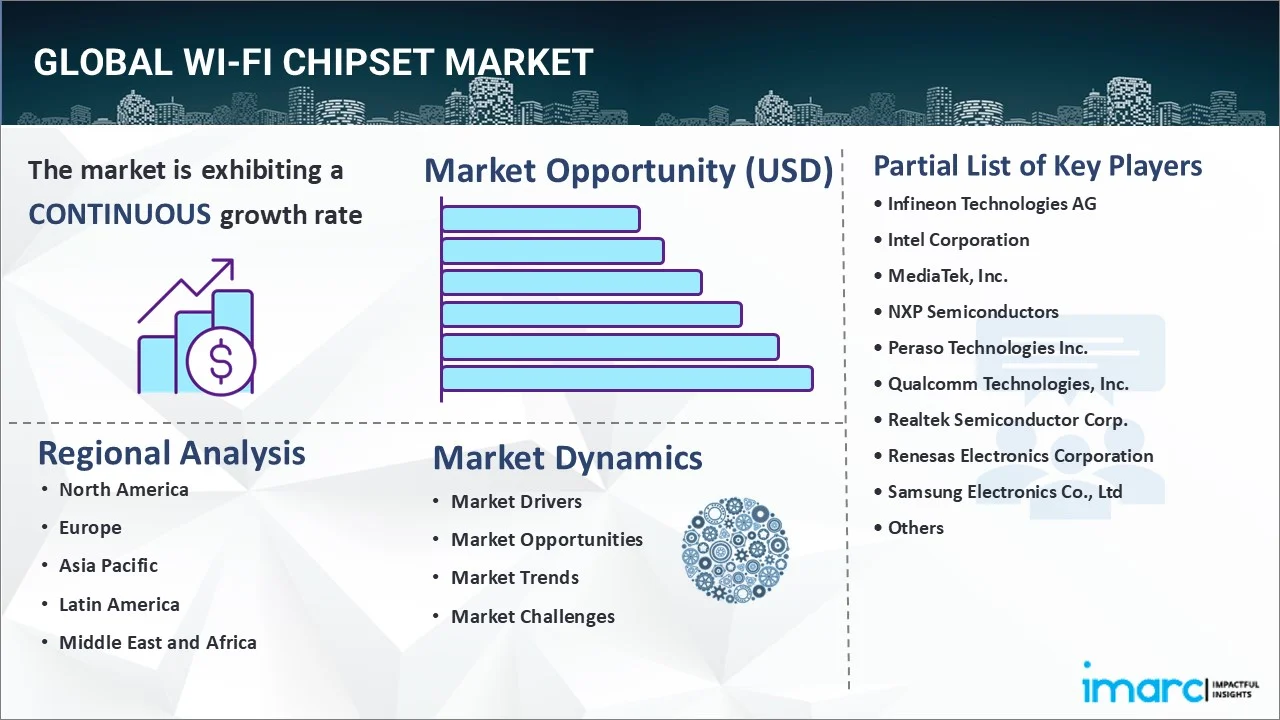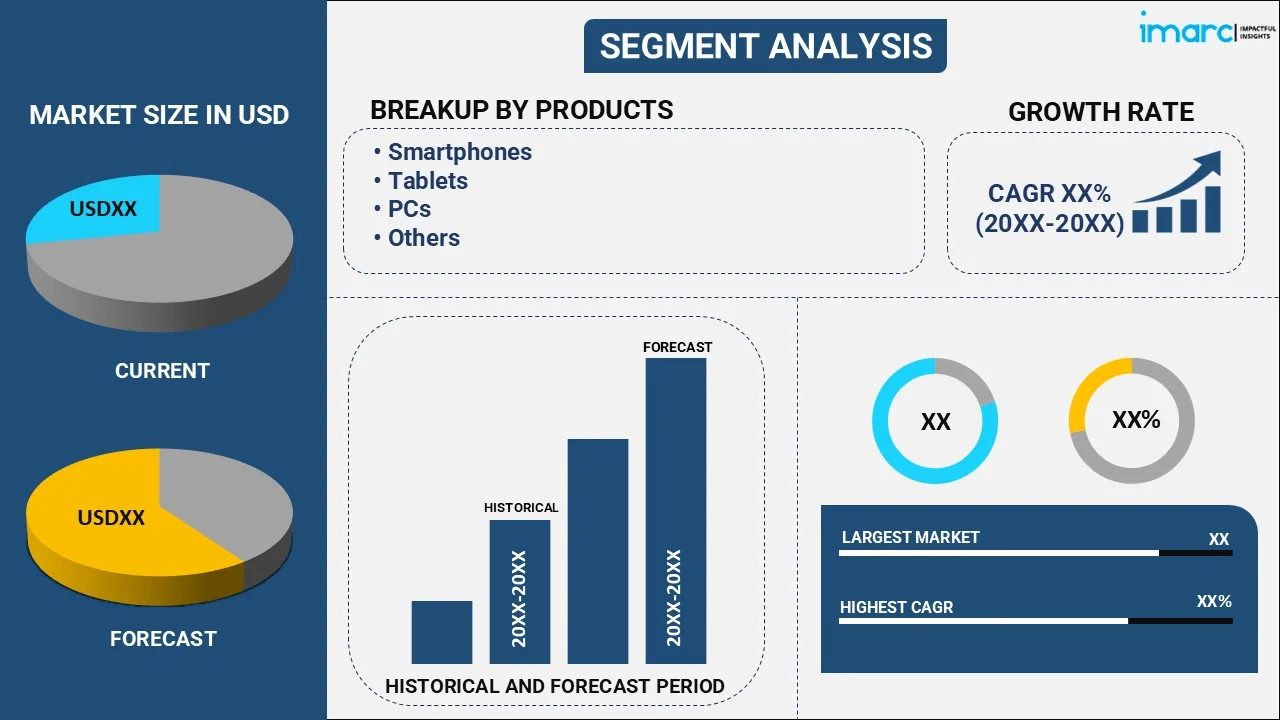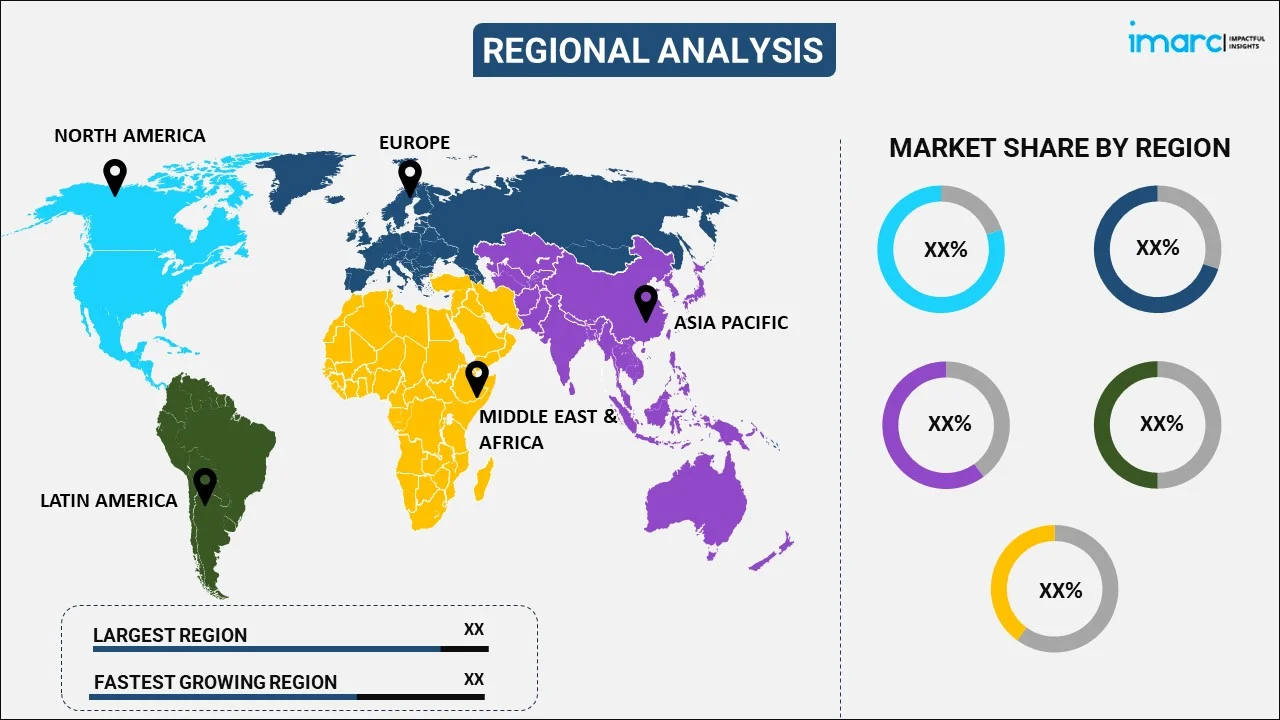
Wi-Fi Chipset Market Report by Product (Smartphones, Tablets, PCs, Access Point Equipment, Connected Home Devices, and Others), Band (Single Band, Dual Band, Tri Band), MIMO Configuration (SU-MIMO, MU-MIMO), and Region 2025-2033
Wi-Fi Chipset Market Size:
The global Wi-Fi chipset market size reached USD 20.5 Billion in 2024. Looking forward, IMARC Group expects the market to reach USD 26.5 Billion by 2033, exhibiting a growth rate (CAGR) of 2.74% during 2025-2033. The market is primarily driven by considerable growth in the adoption of smartphones and smart home devices, rapid expansion of IoT technologies, increasing demand for high-speed internet, continual advancements in Wi-Fi technology (Wi-Fi 6, 6E, 7), and the development of smart cities.
|
Report Attribute
|
Key Statistics
|
|---|---|
|
Base Year
|
2024
|
|
Forecast Years
|
2025-2033
|
|
Historical Years
|
2019-2024
|
|
Market Size in 2024
|
USD 20.5 Billion |
|
Market Forecast in 2033
|
USD 26.5 Billion |
| Market Growth Rate 2025-2033 | 2.74% |
Wi-Fi Chipset Market Analysis:
- Major Market Drivers: The increasing adoption of smart devices and the Internet of Things (IoT) is significantly driving the demand for Wi-Fi chipsets. The rise in internet users and the need for high-speed connectivity are propelling market growth.
- Key Market Trends: There is a notable shift towards Wi-Fi 6 and Wi-Fi 6E technologies, which offer enhanced speed and efficiency. The integration of Wi-Fi chipsets in automotive and industrial applications is also becoming increasingly prevalent.
- Geographical Trends: North America has the largest Wi-Fi chipset market share, driven by high smartphone penetration and extensive manufacturing capabilities. Asia Pacific is also experiencing rapid growth due to advanced technology adoption and significant investments in 5G infrastructure.
- Competitive Landscape: Some of the key market players include Infineon Technologies AG, Intel Corporation, MediaTek, Inc., NXP Semiconductors, Peraso Technologies Inc., Qualcomm Technologies, Inc., Realtek Semiconductor Corp., Renesas Electronics Corporation, Samsung Electronics Co., Ltd, STMicroelectronics N.V., Texas Instruments Incorporated, etc.
- Challenges and Opportunities: The market faces challenges such as higher power consumption and security concerns related to Wi-Fi networks. However, advancements in low-power chipsets and enhanced security features present substantial opportunities for growth.

To get more information on this market, Request Sample
Wi-Fi Chipset Market Trends:
Rising trend of automation
The increased global adoption of IoT (Internet of Things) in the residential, industrial, and commercial sectors has created a desire for enhanced automation, which in turn drives demand for wireless chipsets. Automation integration across applications increases productivity, adaptability, dependability, security, output, processing speed, convenience, and cost-effectiveness. Nonetheless, more Internet of Things connections in various industries are expected to drive the wireless chipset market's growth in the next years. For example, the European Telecommunications Network Operators' Association (ETNO) claims that there are already approximately 16 million Internet of Things connections installed in smart buildings across Europe, with the figure predicted to reach 154 million by the end of 2025. This, in turn, is expected to expand the Wi-Fi chipset market size.
Increasing need for an enhanced network
The increased demand for improved network, low latency, and capacity communications across companies is expected to drive the market during the forecast period. The enormous increase in data traffic has pushed the demand for excellent network connectivity across multiple verticals, including corporate and industrial. As a result, it is projected that the number of wi-fi devices installed will expand during the coming years, as will the demand for chipsets. This, in turn, will lead to the expansion of the market in the Wi-Fi chipset market forecast period. Broadcom Inc. announced the BCM4389 in 2020, marking the world's first Wi-Fi 6E consumer product. The device increases the level to support the soon-to-be-workable 6 GHz spectrum as well as wider 160 MHz channel bandwidths, increasing speeds and lowering latency in half over the prior device. The BCM4389 provides real-world speeds of over 2 Gbps and up to 5 times better energy consumption, making it an ideal solution for future Augmented Reality/Virtual Reality (AR/VR) devices and flagship smartphones. The advantages of the new chipset technology over the legacy wireless standard are predicted to greatly increase its adoption between 2022 and 2030. This, in turn, will show positive growth in the Wi-Fi chipset market research report.
Growing adoption of Augmented Reality/ Virtual Reality (AR/VR)
The market players are rapidly developing to increase operational efficiency. Modern gadgets such as Augmented Reality/Virtual Reality, wireless cameras, and collaborative robots are gaining traction in the manufacturing sector. Improved wireless network connectivity is required for these gadgets to function seamlessly. Over the next few years, it is predicted to increase the adoption of Wi-Fi 6 and 6E devices, as well as their components. Furthermore, expanding e-learning trends across colleges and institutions require unified network connectivity to ensure uninterrupted services. Thus, it is expected to drive the worldwide Wi-Fi chipset market expansion and show positive Wi-Fi chipset market insights in the future years.
Wi-Fi chipset Market Segmentation:
IMARC Group provides an analysis of the key trends in each segment of the market, along with forecasts at the global and regional levels for 2025-2033. Our report has categorized the market based on product, band, and MIMO configuration.
Breakup by Product:

- Smartphones
- Tablets
- PCs
- Access Point Equipment
- Connected Home Devices
- Others
Smartphones dominate the market
The report has provided a detailed breakup and analysis of the market based on the product. This includes smartphones, tablets, PCs, access point equipment, connected home devices, and others. According to the report, smartphones represented the largest segment.
Smartphones are a major segment leading to the overall Wi-Fi chipset market growth. With increasing reliance on mobile internet for everyday activities, the demand for faster, more reliable Wi-Fi connections has accelerated. Advanced smartphones require high-performance Wi-Fi chipsets to support data-intensive applications, seamless streaming, and high-speed downloads. The proliferation of features like augmented reality, IoT integration, and cloud services on smartphones further impels the need for robust Wi-Fi connectivity. Manufacturers are continually innovating Wi-Fi chipsets to meet these demands, resulting in more efficient, powerful, and energy-saving solutions.
Breakup by Band:
- Single Band
- Dual Band
- Tri Band
Dual band holds the largest share in the market
A detailed breakup and analysis of the market based on the band have also been provided in the report. This includes single band, dual band, and tri band. According to the report, dual band accounted for the largest market share.
Dual band technology is mostly preferred since it offers improved performance and flexibility. By operating on both 2.4 GHz and 5 GHz frequencies, dual band Wi-Fi chipsets enhance connectivity, reduce interference, and support higher data rates. This versatility meets the growing demand for seamless, high-speed internet across various devices and applications. Leading chipset manufacturers are incorporating dual band capabilities to cater to smart homes, IoT devices, and bandwidth-intensive activities like streaming and gaming. As a result, dual band Wi-Fi chipsets are becoming the standard, driving market growth and setting new benchmarks for wireless communication.
Breakup by MIMO Configuration:
- SU-MIMO
- MU-MIMO
SU-MIMO holds the maximum share in the market
A detailed breakup and analysis of the market based on the MIMO configuration have also been provided in the report. This includes SU-MIMO and MU-MIMO. According to the report, SU-MIMO accounted for the largest market share.
According to the Wi-Fi chipset industry report, the SU-MIMO segment dominates the market. SU-MIMO (Single-User Multiple Input Multiple Output) dominates the Wi-Fi chipset market due to its ability to significantly enhance network performance by allowing multiple data streams to be transmitted simultaneously to a single device, improving data transfer rates and efficiency. This technology is widely adopted in various devices, including smartphones, laptops, and routers, ensuring broad compatibility and a robust ecosystem. Additionally, SU-MIMO is more cost-effective compared to more advanced MIMO technologies like MU-MIMO, making it an attractive option for manufacturers. Its simplicity and reliability in implementation, along with its established presence in Wi-Fi standards, further cement SU-MIMO's dominance in the market by providing a balanced solution that meets the performance and cost needs of users and applications.
Breakup by Region:

- North America
- Europe
- Asia Pacific
- Middle East and Africa
- Latin America
North America leads the market, accounting for the largest Wi-Fi chipset market share
The market research report has also provided a comprehensive analysis of all the major regional markets, which include North America, Europe, Asia Pacific, Middle East and Africa, and Latin America. According to the report, North America represents the largest regional market for Wi-Fi chipset.
Wi-Fi chipset market dynamics in North America is primarily driven by the growing deployment of 5G technology. According to GSMA Intelligence's most recent Mobile Economy North America 2020 research, 5G will account for more than half of all mobile connections in North America. By 2025, 51% of the region's 426 million mobile connections are expected to use 5G networks. The survey also predicts that the region will reach 340 million mobile consumers by 2025. Due to the rapid increase in the demand for Wi-Fi chipsets in the region, the companies intend to create new products to fulfill market demand, creating a positive for Wi-Fi chipset market outlook. For example, in March 2022, Broadcom, a provider of Wi-Fi chips for client devices and network infrastructure, said that it had shipped one billion Wi-Fi 6/6E chips. This also suggests that Broadcom has shipped 500 million Wi-Fi 6/6E chips in a single year. The corporation also suggests that Wi-Fi 7 will be available in the near future.
Competitive Landscape:
The market research report has provided a comprehensive analysis of the competitive landscape. Detailed profiles of all major companies have also been provided. Some of the key players in the market include:
- Infineon Technologies AG
- Intel Corporation
- MediaTek, Inc.
- NXP Semiconductors
- Peraso Technologies Inc.
- Qualcomm Technologies, Inc.
- Realtek Semiconductor Corp.
- Renesas Electronics Corporation
- Samsung Electronics Co., Ltd
- STMicroelectronics N.V.
- Texas Instruments Incorporated
(Please note that this is only a partial list of the key players, and the complete list is provided in the report.)
The key players in the market are investing in innovating their product and service offerings to cater to the industry's changing demands. As a result, the Wi-Fi chipset industry outlook is poised for significant growth, with enhanced performance, greater energy efficiency, and the integration of advanced technologies such as Wi-Fi 6 and Wi-Fi 7. Moreover, players are adopting strategic initiatives like partnerships, mergers, and acquisitions to expand their presence. Moreover, companies are focusing on developing cost-effective chipsets to capture a broader customer base, especially in emerging markets. They are also investing heavily in R&D to pioneer next-generation Wi-Fi solutions that support the growing IoT ecosystem. Additionally, key players are enhancing their supply chain resilience to ensure timely delivery and reduce the impact of global semiconductor shortages. This, in turn, is bolstering wi-fi chipset market revenue.
Wi-Fi Chipset Market News:
- June 3, 2024: At Computex 2024, Qualcomm unveiled Copilot+ PCs powered by Snapdragon X Elite and Snapdragon X Plus processors, featuring industry-leading AI capabilities, multi-day battery life, and support from major tech companies, available for pre-order and purchase starting June 18.
- June 11, 2024: Texas Instruments Incorporated introduced the industry's first 650V three-phase GaN IPM for 250W motor drive applications. The new GaN IPM addresses many of the design and performance compromises engineers typically face when designing major home appliances and heating, ventilation, and air-conditioning (HVAC) systems.
Wi-Fi Chipset Market Report Scope:
| Report Features | Details |
|---|---|
| Base Year of the Analysis | 2024 |
| Historical Period | 2019-2024 |
| Forecast Period | 2025-2033 |
| Units | Billion USD |
| Scope of the Report | Exploration of Historical Trends and Market Outlook, Industry Catalysts and Challenges, Segment-Wise Historical and Future Market Assessment:
|
| Products Covered | Smartphones, Tablets, PCs, Access Point Equipment, Connected Home Devices, Others |
| Bands Covered | Single Band, Dual Band, Tri Band |
| MIMO Configurations Covered | SU-MIMO, MU-MIMO |
| Regions Covered | Asia Pacific, Europe, North America, Latin America, Middle East and Africa |
| Companies Covered | Infineon Technologies AG, Intel Corporation, MediaTek, Inc., NXP Semiconductors, Peraso Technologies Inc., Qualcomm Technologies, Inc., Realtek Semiconductor Corp., Renesas Electronics Corporation, Samsung Electronics Co., Ltd, STMicroelectronics N.V., Texas Instruments Incorporated, etc. |
| Customization Scope | 10% Free Customization |
| Post-Sale Analyst Support | 10-12 Weeks |
| Delivery Format | PDF and Excel through Email (We can also provide the editable version of the report in PPT/Word format on special request) |
Key Questions Answered in This Report:
- How has the global Wi-Fi chipset market performed so far, and how will it perform in the coming years ?
- What are the drivers, restraints, and opportunities in the global Wi-Fi chipset market ?
- What is the impact of each driver, restraint, and opportunity on the global Wi-Fi chipset market ?
- What are the key regional markets ?
- Which countries represent the most attractive Wi-Fi chipset market ?
- What is the breakup of the market based on the product ?
- Which is the most attractive product in the Wi-Fi chipset market ?
- What is the breakup of the market based on the band ?
- Which is the most attractive band in the Wi-Fi chipset market ?
- What is the breakup of the market based on the MIMO configuration ?
- Which is the most attractive MIMO configuration in the Wi-Fi chipset market ?
- What is the competitive structure of the market ?
- Who are the key players/companies in the global Wi-Fi chipset market ?
Key Benefits for Stakeholders:
- IMARC’s industry report offers a comprehensive quantitative analysis of various market segments, historical and current market trends, market forecasts, and dynamics of the Wi-Fi chipset market from 2019-2033.
- The research report provides the latest information on the market drivers, challenges, and opportunities in the global Wi-Fi chipset market.
- The study maps the leading, as well as the fastest-growing, regional markets.
- Porter's five forces analysis assists stakeholders in assessing the impact of new entrants, competitive rivalry, supplier power, buyer power, and the threat of substitution. It helps stakeholders to analyze the level of competition within the Wi-Fi chipset industry and its attractiveness.
- The competitive landscape allows stakeholders to understand their competitive environment and provides insight into the current positions of key players in the market.
Need more help?
- Speak to our experienced analysts for insights on the current market scenarios.
- Include additional segments and countries to customize the report as per your requirement.
- Gain an unparalleled competitive advantage in your domain by understanding how to utilize the report and positively impacting your operations and revenue.
- For further assistance, please connect with our analysts.
 Request Customization
Request Customization
 Speak to an Analyst
Speak to an Analyst
 Request Brochure
Request Brochure
 Inquire Before Buying
Inquire Before Buying




.webp)




.webp)












